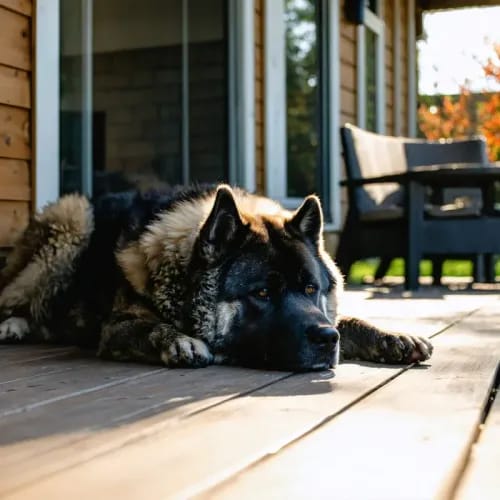Akita Breed Guide
Also known as: Akita Inu, Japanese Akita, American Akita
Dignified and powerful, Akitas form deep bonds with their people while maintaining the independent spirit that defines this noble breed.

Quick facts about this breed
Size
Large
Weight
32-59 kg
Lifespan
10-15 years
Energy Level
Medium
Family Fit
teens_adults
Shedding
High
Size
Large
Weight
32-59 kg
Lifespan
10-15 years
Energy Level
Medium
Family Fit
teens_adults
Shedding
High
About Akitas
The Akita originated in the mountainous regions of northern Japan during the 17th century, where they were initially bred by samurai to hunt wild boar, black bear, and other large game. These powerful spitz-type dogs were considered symbols of good health, happiness, and long life in Japanese culture.
Akitas are known for their dignified, courageous, and profoundly loyal nature. The breed gained international recognition after the famous Hachiko, an Akita who waited for his deceased owner at a train station for nearly 10 years.
Their thick double coat comes in various colours and sheds heavily twice yearly. Akitas are naturally protective and can be reserved with strangers, making early socialisation crucial. While generally healthy, prospective owners should be aware of potential hip dysplasia, thyroid issues, and certain eye conditions.
Complete Care Guide for Akitas
Expert advice on keeping your Akita healthy, happy, and thriving at every stage of life.
Providing proper nutrition for an Akita requires careful attention to their unique dietary needs as a large, muscular breed with a distinctive double coat. A well-balanced diet rich in high-quality protein supports their substantial muscle mass, while essential fatty acids contribute to maintaining their thick fur in optimal condition.
Portion control plays a vital role in keeping these powerful dogs at a healthy weight. Despite their size, Akitas can be prone to weight gain, which may impact their joint health and overall wellbeing. Establishing consistent feeding schedules and measuring portions helps prevent overfeeding.
Food sensitivities warrant special consideration in Akitas, as they may not always display obvious signs of digestive discomfort. Monitoring their response to different ingredients helps identify potential allergies or intolerances early. Watch for subtle changes in behaviour, coat condition, or digestive patterns that might indicate dietary issues.
Supporting coat health through nutrition becomes particularly important during seasonal changes when shedding increases. A diet rich in omega-3 and omega-6 fatty acids helps maintain coat lustre and skin health throughout the year. Regular assessment of their body condition and consultation with veterinary professionals ensures their nutritional needs continue to be met as they age.
How healthy is your Akita?
A two minute quiz for your personalised results and health plan.
Frequently Asked Questions
Get answers to the most common questions about Akitas from our community of pet parents
Akitas are known for their loyalty, dignity, and courage. They are often reserved with strangers but affectionate with family members. As a breed, Akitas are intelligent, strong-willed and can be quite independent, making consistent, positive reinforcement training important. Despite their sometimes stoic demeanor, they are known to be good protectors of their families.
Akita Blog Posts & Guides
Expert advice and tips specifically for Akita owners
Dog Breeds Similar to Akita
Explore breeds with comparable temperament, size, and care requirements to the Akita

Shiba Inu
Japan's fox-like companions, Shiba Inus are independent, spirited dogs whose clean habits and confident nature appeal to those appreciating primitive breeds.

Chow Chow
Lion-like and aloof, Chow Chows are dignified spitz breeds whose independence and fluffy coats attract owners who appreciate feline-like qualities.





